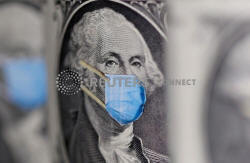Dollar steadies after falling on sharper risk appetite
 Send a link to a friend
Send a link to a friend
 [October 06, 2020] By
Olga Cotaga [October 06, 2020] By
Olga Cotaga
LONDON (Reuters) - The dollar stabilised on
Tuesday after weakening against most currencies in earlier trade, as
rising optimism that U.S. lawmakers could agree on new stimulus to blunt
the economic impact of the coronavirus dampened demand for safer assets.
Risk appetite also improved after U.S. President Donald Trump left
hospital and returned to the White House following treatment for
COVID-19, a development viewed as reducing political uncertainties in
the near term.
The lead taken by Trump's presidential opponent Joe Biden in polls ahead
of next month's election is also seen as negative for the U.S. currency.
"The increasing possibility of a "blue wave" (Democrat control of the
White House and Congress) that would open the door for much-needed
fiscal stimulus would be a welcome development for risk assets and could
undermine the U.S. dollar," said Lee Hardman, currency analyst at MUFG.
An index which measures the dollar against a basket of currencies was
last flat at 93.49 <=USD>. It has fallen around 1% from a two-month high
reached at the end of September, in contrast with U.S. equity markets,
which rose.
Euro/dollar was also flat at 1.1779 <EUR=EBS>. The British pound fell
0.1%, to $1.2967 <GBP=D3>, though hopes of a Brexit deal kept the
currency close to $1.30. The dollar was 0.2% weaker versus the Japanese
yen at 105.56 <JPY=EBS>.

U.S. House Speaker Nancy Pelosi and Treasury Secretary Steven Mnuchin
spoke by phone for about an hour on Monday on coronavirus economic
relief and were preparing to talk again on Tuesday, continuing their
recent flurry of activity working towards a deal on legislation.
White House Chief of Staff Mark Meadows said there was still potential
for an agreement among lawmakers in Washington on more economic relief,
and that Trump was committed to getting the deal done.
However, renewed efforts in Congress to reach an agreement on relief
funds for the pandemic-hit economy have been complicated by the spread
of the coronavirus among key policymakers including Trump.
[to top of second column] |

George Washington is
seen with printed medical mask on the one Dollar banknote in this
illustration taken, March 31, 2020. REUTERS/Dado Ruvic/Illustration

The president returned to the White House on Monday after a three-night
hospital stay for COVID-19 treatment, though the White House physician
warned he may not be out of the woods yet.
Deutsche Bank currency analyst George Saravelos said the fiscal stimulus
needed in the United States to fight the coronavirus-induced economic
downturn will be negative for the U.S. dollar because the Federal
Reserve is planning to remain accommodative.
"Is more U.S. fiscal stimulus good or bad for the dollar? It helps
growth, of course. But the Fed is more important," he said.
"It is clear that the Fedís new average inflation-targeting strategy is
explicitly designed to keep the curve very flat and push front-end real
yields as low as possible. Thatís why post-COVID fiscal stimulus is
going to be much more dollar-negative than the Trump one," Saravelos
added.
Among currencies that are not included in the dollar index, the offshore
Chinese yuan weakened 0.1% to 6.7280 per dollar <CNH=D3>, having hit on
Monday its highest since April last year.
The Australian dollar reversed the gains it made after the Reserve Bank
of Australia kept interest rates on hold at 0.25%, despite widespread
expectations of a rate cut. It was last trading at 0.7150, down 0.4% on
the day <AUD=D3>.
Australia will spend A$4 billion over the next year to pay businesses
that hire those under the age of 35, Treasurer Josh Frydenberg said on
Tuesday, part of an ambitious plan to boost jobs and growth.
(Reporting by Olga Cotaga; Editing by Susan Fenton and Jan Harvey)
[© 2020 Thomson Reuters. All rights
reserved.] Copyright 2020 Reuters. All rights reserved. This material may not be published,
broadcast, rewritten or redistributed.
Thompson Reuters is solely responsible for this content.
 |